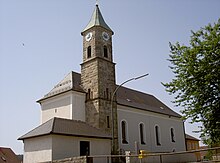St. Georg (Etzgersrieth)
The church of St. Georg in Etzgersrieth is today a branch church of the Roman Catholic parish of Moosbach . The church is located in the district of Etzgersrieth in the Upper Palatinate district of Neustadt an der Waldnaab (Etzgersrieth 33).
history
Count Palatine Rudolf and his brother Ludwig gave the St. Emmeram monastery the patronage rights of the Moosbach parish and the associated branches, including Etzgersrieth. A parish of Etzgersrieth was first mentioned in a document on January 30, 1300 as a parish belonging to the St. Emmeram monastery. Etzgersrieth was previously probably a branch of the Moosbach parish. The parish of Etzgersrieth is neither mentioned in the parish register of the Diocese of Regensburg from 1326 nor in that of 1350. In contrast, Etzgersrieth is mentioned in the Salbuch of the Propstei Böhmischbruck from 1336. In 1352 Etzgersrieth came to the parish of Böhmischbruck .
From 1566 to 1626, during the Reformation , Lutheran and from 1559 Calvinist pastors served here . Since Etzgersrieth was occupied by its own pastor at this time, it is viewed as a parish, occasionally also as a "branch with its own church service". From 1626, Etzgersrieth had become Catholic again, pastoral care was provided by the pastor Johannes Sprenger von Tännesberg and - after the parish of Böhmischbruck was reoccupied - by this parish, initially by French emigrants.
During the Thirty Years' War , the church burned down along with the whole place in 1634. In 1667 the medieval church (with a barrel vault ) was damaged again by lightning. The apparently Romanesque church was cramped and too small for the residents and had to be closed because it was dilapidated. The Etzgersriether therefore had to go to church in Böhmischbruck. As a result, it was decided to rebuild the church. The plan for this came from the master mason Dobmeier von Waidhaus . However, the citizens refused to do the manual and clamping services for free, since the church had cash assets of 3800 fl and outstanding debts of 1424 fl. In February 1738 the building permit was granted, whereby the tower remained standing and only the nave was to be rebuilt. The construction costs amounted to 1416 florins . However, this church burned down again on July 16, 1816, and the whole place was also destroyed by flames. The cooperator Jakob Seitl gave the blessing when the fire broke out. The paraments and the church implements could be saved, however, the bells melted together.
The old walls could still be used during the reconstruction, but the tower had to be rebuilt. In September 1838 a service could be held here again. The consecration took place on April 30, 1838 Father Emanuel Hannecker from Pfreimd . An expansion of the church was approved on May 15, 1914. The architect Heinrich Hauberrisser from Regensburg made the plans for this .
Since August 6, 1912 Etzgersrieth an exposed Kooperatur (= Expositur ). Pastor Rackl from Böhmischbruck had sent a petition to the Bishop of Regensburg for this, as the living conditions of the cooperator in Böhmischbruck were very cramped. The first exposure was Lorenz Lippert (1912–1922). The Expositus Josef Losch (1933–1938) was arrested by the Gestapo and hanged on January 29, 1945 shortly before the end of the war in the Plötzensee prison in Berlin. A memorial plaque inside the church commemorates him. Under Expositus Josef Busl (1954–1959) the wooden belfry was replaced by an iron one and the first morgue was built. Under Expositus Georg Bodner (from 1959) the shingle roof was replaced by slate, the church tower covered with a copper roof and the church tower cross was gilded. An interior renovation also had to be carried out during his time, as the church was smoky due to a smoldering fire at the high altar. The ceiling paintings were freshened up by the church painter Johann Rauch.
Since February 1, 2005 the branch has belonged to the Moosbach parish.
Interior design
The high altar is a baroque carving with two columns. The tabernacle is built in between these . The altar is consecrated to the church patron, St. George . The altarpiece shows him as a dragon slayer in a landscape that corresponds to Etzgersrieth. The left side altar is dedicated to the Virgin Mary ; the altarpiece shows the Holy Family with the baby Jesus in the middle. The right side altar is consecrated to Saint Wolfgang , Bishop of Regensburg and patron of the Regensburg diocese. The pulpit is also a masterpiece of baroque carving. The most valuable work in the church are the two angels in frescoes that were exposed during the last renovation to the right and left of the high altar.
Also worth mentioning is the baroque and carved wood representation of the baptism of Jesus on the cover of the baptismal font. In 1838 a way of the cross was also purchased from Güpen'schen Kunsthandlung in Munich for 500 marks.
The church was painted in 1918 by the decorative painter Aichlmayer from Tirschenreuth and the painter Thoma from Munich. The church ceiling is painted with depictions from the life of Jesus.
organ
After the fire in the church in 1838, the organ maker Xaver Ehrlich von Bärnau made a cost proposal for a new organ worth 316 florins. In 1914, a new organ was installed by the Edenhofer company .
literature
- Georg Bodner: Expositur Etzgersrieth. In Siegfried Poblotzki, Markt Moosbach. Historical summary and various reports . Markt Moosbach, Moosbach 1987, pp. 41-44.
- Siegfried Poblotzki : History of the market Moosbach . Markt Moosbach, Moosbach 1982, pp. 390-398.
Web links
Individual evidence
- ↑ Homepage of the Parish Moosbach
- ↑ Historical Atlas of Bavaria, Altbayern Series I, Issue 39: Vohenstrauss. Komm. Für Bayerische Landesgeschichte, Munich 1977, p. 71.
Coordinates: 49 ° 33 '38 " N , 12 ° 22' 49.9" E


